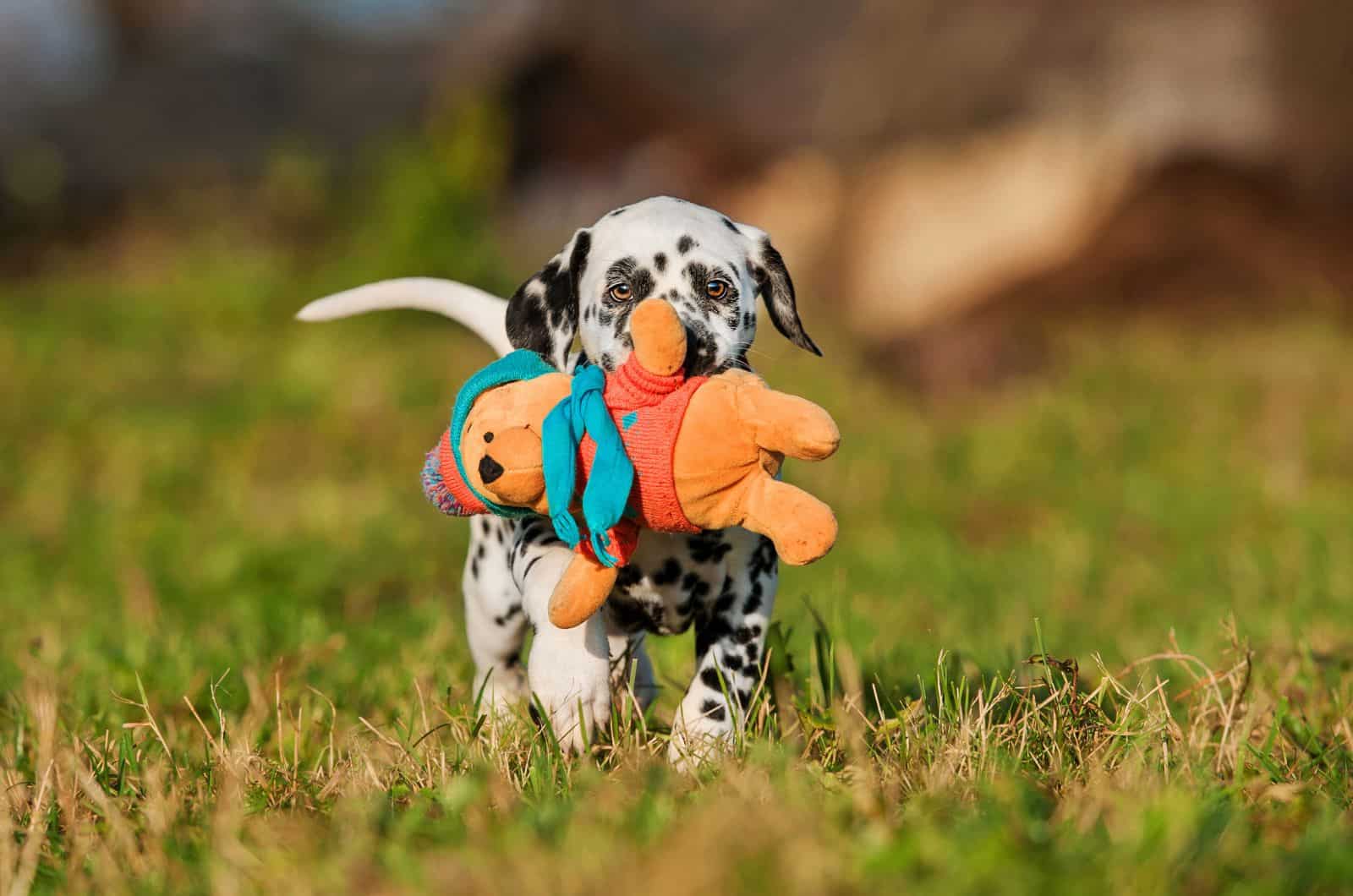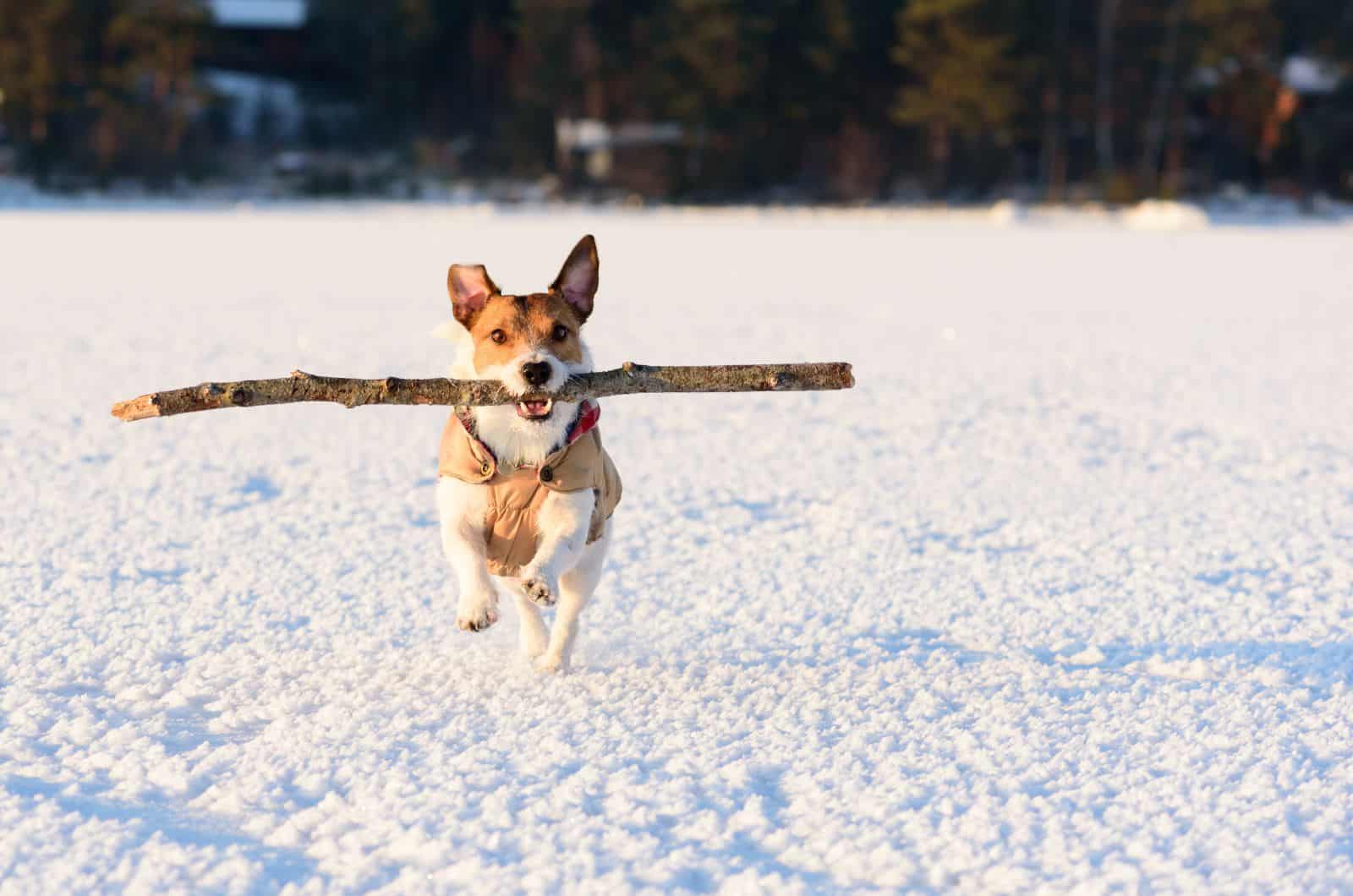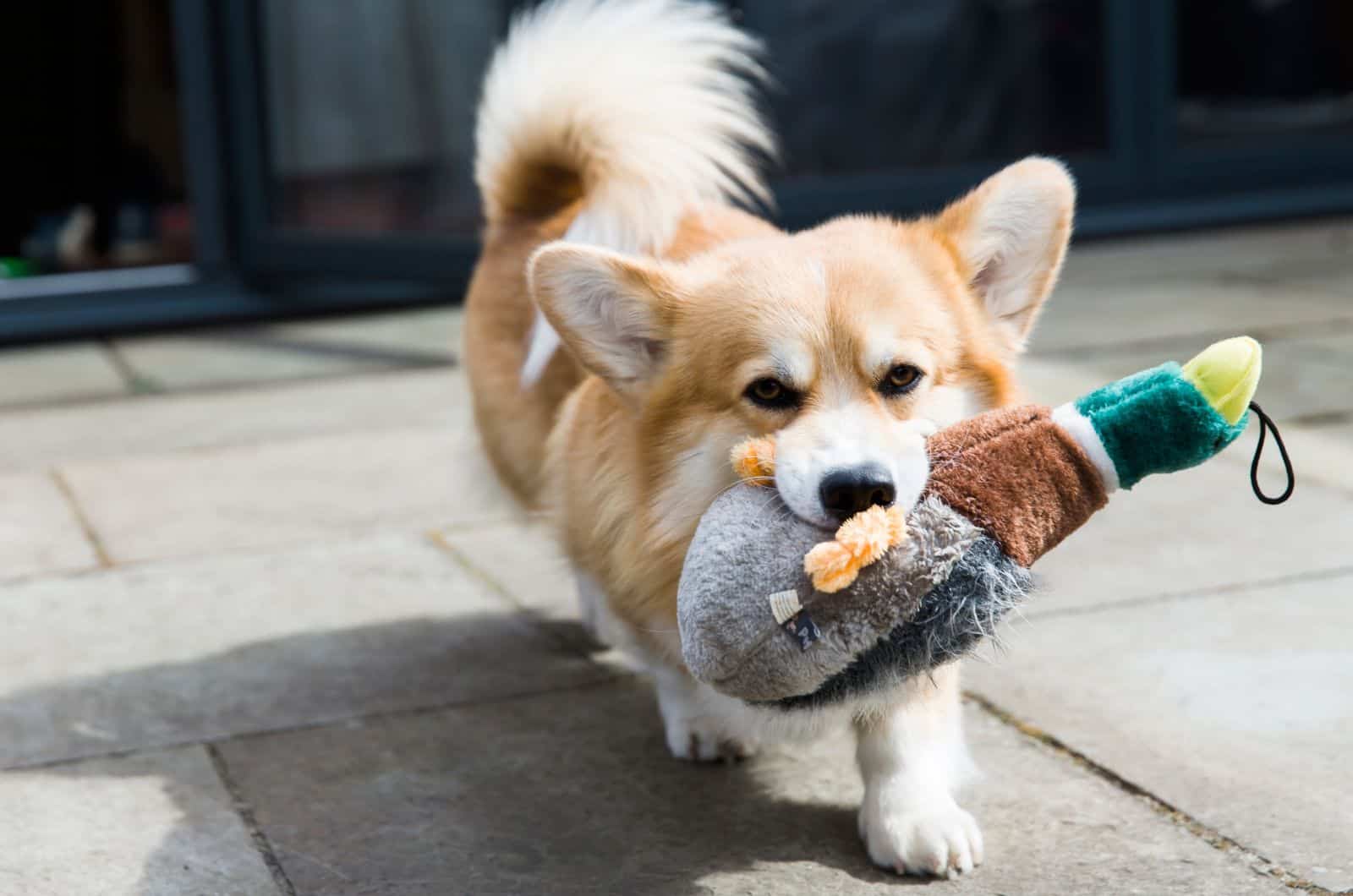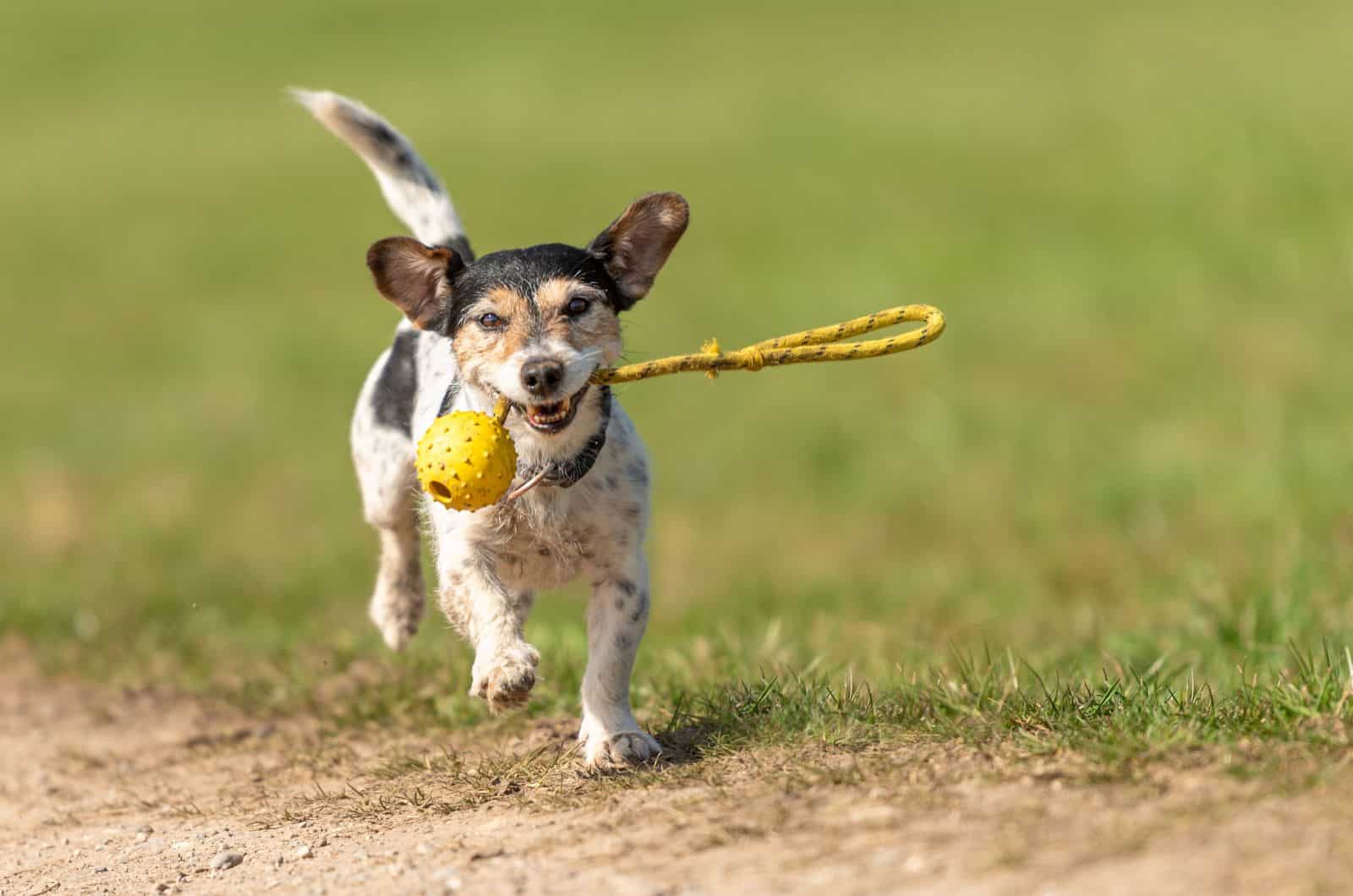Dogs are fascinating creatures, always doing something interesting or funny! Especially when they play with their toys. They can jump around the toy, bark at it, toss it, and shake it. But, when the dog cries while it carries its toy, that can leave us puzzled!
Why does my dog cry when carrying toys? Is it angry or hurt? Does it want to say something?
Maybe they need a new toy? Let’s take a peek at their pretty doggy brains a bit.
Why Does My Dog Cry When Carrying Toys?

All dogs need time to play with their dog toys and work out their teeth and grey cells. The good thing is that most dogs are not picky when it comes to their toys. They can gnaw on a stick, chew a squeaky toy, or try to shake and rip a stuffed toy.
But, when a dog whines during playtime, dog owners cannot put a finger on a specific reason why their dogs do it. We love our pooches so it is only normal to try and find the reason behind such behavior.
So, what’s the deal? Why does my dog cry when carrying toys?
Dog Vocalization
Dogs are mammals with a highly developed social hierarchy, communicating through body language and vocalization.
People have been learning about dogs and their behavior for a long time, and today, we have special dog behaviorists doing their best work to more thoroughly understand all the actions of a dog. That includes their vocalization during playtime, among other situations.
Dogs are vocal creatures, and some of their vocalization sounds include: barking, whining, growling, howling, etc. A dog crying sounds louder and more expressive than whimpering or whining.
They use their barks and cries and other sounds to warn off intruders, to tell us they are hungry, that they want to go potty, to show us love and affection, to attack prey, and in many other social and instinctive situations.
Here are some of the reasons why they might use their vocal cords during playtime and start crying.
1. Playing Vocalization
Dogs can simply cry while carrying their toy because that’s how they like to play at that moment.
They might not do it every time, but they can. Also, it can be seen while they play with their new toy or a favorite toy.
When it comes to vocalization during playtime, it doesn’t mean they only cry and whimper, they can bark and growl, too. Or they can make other sounds as well.
But, some dogs prefer these characteristically doggy cries while playing.
If you watch your dogs long enough while they are playing alone, on their own, you can notice signs that can help you solve this mystery. If they do not show any signs of discomfort, of which we will talk later, and you know they are not in pain or have some health issues, then your dogs are A-OK.
They are just playing and they like to cry and whine while they do it.
You don’t have to worry about your doggo.
2. Frustration
Dogs have emotions too, and if you are one to believe we all have a soul, then you must have asked this question do dogs have souls too? Well, if you believe in both, then you will understand why frustration expressed through vocalization is equally possible in humans and dogs. Why?
Well, what do you do when you can’t solve your own problem and you need to do it quickly? Some of us stay relaxed, but most of us get a bit frustrated! It’s the same with dogs.
They can get frustrated while playing with their toys and instinctively start crying while carrying a toy. Why do dogs get frustrated while playing?
One of the reasons dogs can get frustrated while playing is their innate desire to bury their valuable possessions.
They are playing, they are loving their toy, like the Agnes from Despicable Me loves her Unicorn, and they want to save it for later and keep it safe until then! What do dogs do? They bury things!
What happens if your dog cannot bury its favorite toy? They start to cry and walk around the house making those crying noises.
It’s not a pleasant sound, especially if you are having a Zoom call or you need to relax, but at least now you know your dog is alright and the problem can be fixed.
3. Excitement Vocalization
OK, let’s compare it to a group of teenage girls seeing Justin Bieber walking out on the stage. They are excited and they scream and shout, showing they are having a good time.
Well, dogs can cry in excitement, too! Not for Justin Bieber, but for their stuffed animal!
This type of vocalization is more common in puppies than in adult dogs. It also can vary from breed to breed, where some dog breeds are more prone to show their excitement through vocalization.
Dog breeds like Siberian Husky, Chihuahua, Beagle, Yorkie, Pitbull, and German Shepherd are some of the more vocal dog breeds out there. It has to do with their breeding history and the purpose behind why they were bred in the first place, as well as the temperament and early socialization of the dog. They have high hunting instincts and can even get overly excited with their toys, and even obsessed with a fast-moving toy like a ball.
On the other hand, dog breeds like Basenji, Great Dane, Borzoi, etc. are less vocal breeds.
Of course, exceptions are possible in all cases, so you can have a very quiet Yorkie and a highly vocal Great Dane.
4. Pain

When it comes to animals and the pain they are experiencing, there are a few signs we can catch early on and help them at the very beginning of a possible health issue.
Most animals, including dogs, are great at hiding their health issues. We end up noticing the problem when the disease is in a more developed stage. That is why it’s important to notice even the slightest changes in the behavior of our dogs.
Did your dog start crying while carrying its favorite chew toy only recently? Can you see some other behavioral changes, like avoiding food? If this is the case, then your dog might be in pain, and the reason they are crying while they have a dog toy to soothe themselves.
Or in other words, they are looking for something that used to bring them happiness and joy – their favorite toy. They will carry the toy around, hoping it will help them feel better.
If you suspect your dog might be in pain, don’t hesitate to take the dog to the local vet and see what the problem might be.
5. False Pregnancy
The other terms for false pregnancy are pseudocyesis, phantom pregnancy, or pseudo-pregnancy.
It happens in unspayed female dogs. They show maternal behavior that is combined with the physical signs of pregnancy.
These signs of a false pregnancy show after an estrus cycle ( after being in heat ), and they usually begin 4 to 9 weeks after the previous estrus cycle. Being a “fake” or pseudo-pregnancy, the signs include the enlargement of the mammary glands, occasional vomiting, lethargy, and fluid retention.
When the false pregnancy happens, the maternal instincts start to show up and the female dog tries to do everything she can to prepare for her new babies – whether they are truly coming or not. She will start nesting, become less active, and restless, and she can sometimes choose a particular toy and carry it around while crying.
False pregnancy can happen in all female dogs, no matter if they have been mated or not.
In fact, the majority of intact female dogs will exhibit some signs of a false pregnancy after the estrus cycle ends. There are some signs that can tell you if your dog is pregnant, for example, vomiting or changes in appetite.
6. Possessiveness
When it comes to their dog food and their favorite toy, some dogs are more possessive than others.
The possessiveness can be seen in a form of crying, growling, barking, nipping, and sometimes lunging – if the dog is too possessive and has other aggressiveness issues.
A possessive dog keeps carrying toys around the house, from the bedroom to the living room, making crying sounds. For some pet owners, this can be worrying and annoying.
They can also growl or show teeth if you try to take the toy away or they can show these signs of aggressive and possessive behavior towards other dogs in the house.
The possessiveness vocalization happens in both male dogs and females and it can be seen in puppies, as well.
This is not a desirable trait in any dog breed and every breeder knows that this dog behavior needs to be adjusted. If you are unable to do it yourself, you can always hire a professional dog trainer to correct the behavior.
A lot of reasons can lead to possessiveness and vocalization, but one thing sure solves the problem: early proper socialization of a puppy.
7. Anxiety
Sometimes dogs tend to be anxious or nervous when they are left alone in a house. It has to happen if we have a working family and everyone has to leave home during the day.
But, while some dogs take it easy, do their own thing, and wait for you, there are others that might find comfort in their favorite toy and carry it away crying.
The crying while you are away or right after you get back home is called separation anxiety. Dogs might show some other signs of anxiety like putting their ears back, tails tucked, shivering, etc.
In cases of anxiety vocalization, you can immensely help your dog feel better if you have daily exercise with your doggy in the form of a game like tug-of-war. Especially before you leave home. That way the dog will feel tired enough to fall asleep rather than cry when carrying toys. But, if that’s not possible, you can help your dog by keeping him entertained while you are at work by playing some music for them or leaving the TV on.
8. Hunting Vocalization

This type of vocalization can happen in all dog breeds and mixes, but it is more common in hunting dog breeds or retrievers, for example, bird hunting dog breeds. Why is that? Because these dogs were specifically bred to retrieve the prey and not hurt it. Some breed dogs like this are Golden Retriever, Poodle, English Cocker Spaniel, Brittany, etc.
When they think of their toys as prey, for example, some small animals, dogs cry when they carry them. They can also show signs of being gentle with the toy, trying not to hurt it.
That’s another sign of their hunting nature. They will gently hold the toy and make crying noises, louder or softer depending on the breed, and through such vocalization show you “their prey”.
It’s a game and hunting instincts combined in this situation, so it doesn’t have to apply to hunting dogs. Your Papillon might do it, too.
9. Attention Seeking
Dogs are social tail-wagging beings, and they love their humans! If you are a pet parent, it is certain that you came across attention-seeking dog behavior, no matter if it’s a month-old puppy or a 5-year-old dog.
It usually goes like this: they sniff and find their favorite toy, then they cheerfully go to you, but you are busy. So what does a dog do? They start crying with a toy in their mouth, looking for ways to get your attention! It usually works! So, every time it works they connect the whining and the crying with you turning towards them.
And, they also get louder in order to achieve the desired goal much faster, that is to get you to play with them ASAP.
This is clearly the case of attention-seeking vocalization if they actually sit in front of you with their toy and start crying. They want to play!
You can play fetch with them, or spare a few minutes to play with your very vocal dog.
If you’re unable to do so, you can leave some interactive dog toys or squeaky new toys to help your doggy if it’s feeling bored while you work.
10. Naturally Loud
The answer to the question of why does my dog cry when carrying toys could be as simple as the dog is naturally loud!
Some dog breeds, like the Siberian Husky or Huskies in general, were bred to work in a pack where vocalization is the key to successful work. Those genes can be hard to silence, so the dog whines, whimpers, or in one word cries when it plays with its toy.
Another dog breed that can make a lot of noise while playing is the mighty Beagle! Once again, we have the genes responsible for such behavior. Are Beagles hunting dogs? Yes! They were also specifically bred to do well in a pack, to be organized, and to act quickly and instinctively. One of the ways Beagles did that ( and some working dogs still do ) is to bark and growl, whimper, and make all kinds of other sounds to communicate with the other dogs.
So, next time you see your doggies crying when carrying toys, it might be a strong pack and hunter gene in them that makes them do it.
11. Teething in Pups
This might be a good reason if it’s a puppy that makes all that noise.
Puppies start teething when they are around 3 weeks old. The first set of teeth, or milky teeth, should finish erupting when the pups are around 6 weeks old.
This can be uncomfortable for your puppy. It is not exactly a painful situation, but it can cause some behavioral changes in a dog.
Hypersalivation can occur and puppies can have a loss of appetite during this time. Irritability is another sign and when we combine all of these symptoms, we get to the conclusion that yes – a puppy can cry when carrying toys because of the teething.
When all the teeth erupt, the symptoms will pass, and so will the crying.
But, it is important to pay attention to your pup and make sure it’s the teething that is causing the crying. If you are not sure what is happening or you can’t check the teeth on your own, the best option is to go to your local vet or to the vet clinic.
12. Is It A Wookiee?
OK, not a real Wookiee, but it’s another way to explain these noises similar to crying when they play with their toys.
A Wookiee is the famous Han Solo’s co-pilot called Chewbacca from Star Wars, and many dog owners describe their dogs as making Chewbacca noises.
They are a mixture of throaty rumble noises that can sometimes escalate to whimpering noises, especially when they are carrying and playing with their Chewie toy.
All is well, and your dog is not turning into a famous interstellar warrior. They are just happy, and they make those noises to express their contentment.
What To Do If Your Dog Cries When Carrying Toys?

The answer to this question depends on the cause of such behavior in dogs.
The first thing you should do is to make sure your dog is not in any pain. If you are not certain, taking your dog to the vet is the option. The veterinarian can check your dog and make sure everything is alright.
The veterinarian can also check if your female dog is pregnant or not and whether the pups are in the teething phase.
And, if it’s not the pain and it’s not the teething phase or false pregnancy ( because you have a male dog! ) then the first step is to pay attention to when and how does your dog cry.
If it’s just a playing vocalization or if they are naturally loud, then there’s nothing to worry about. It can be annoying, but you’ve got yourself a vocal dog. You can try some Anti dog barking devices if the noise is too much.
If it’s an attention-seeking vocalization, then we should not react if we don’t have time to play with them. We are ignoring this behavior because reacting to it encourages it.
If the dog shows signs of anxiety with the habit of crying when carrying a toy, we should calm the dog. Physical contact, music, massages, and help from a behavioral dog professional are some of the things we can do to help our anxious pup.
If it’s teething we can help our puppies by offering chewing toys we cooled off previously in a freezer. Cold helps with the discomfort of new teeth erupting and the dog will help the tooth erupt sooner by chewing rubbery objects.
And, if it’s a false pregnancy, spaying your female dog is the solution.
The Conclusion

So, why does my dog cry when carrying toys?
We’ve seen all the possible reasons and the solutions. In most cases, the dog is just happy or it’s in its nature. Sometimes the pain and anxiety can get involved, or a teething discomfort.
False pregnancy in female dogs is a frequent reason, too.
Paying attention to little signs, like dog tail position, can give us valuable insight into what is happening and why they whimper and cry.
These small things, like the position of their tail or body, the time when they cry, and other things, can point us in the right direction and help us find out if the dog is anxious or too attached, if the dog is happy or if it is“hunting”, etc.
All in all, it’s a good thing you asked because now you know the answer and you can get back to buying earplugs or you can take your dog to a vet.















